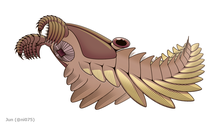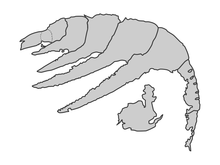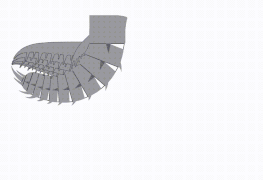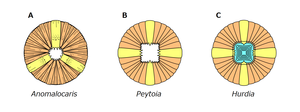Peytoia
| Peytoia Temporal range:
| |
|---|---|

| |
| Fossil specimen of Peytoia nathorsti | |

| |
| Reconstruction of P. nathorsti | |
| Scientific classification | |
| Domain: | Eukaryota |
| Kingdom: | Animalia |
| Phylum: | Arthropoda |
| Class: | †Dinocaridida |
| Order: | †Radiodonta |
| Family: | †Hurdiidae |
| Genus: | †Peytoia Walcott, 1911 |
| Type species | |
| †Peytoia nathorsti Walcott, 1911
| |
| Species | |
| |
| Synonyms | |
| |
Peytoia is a genus of
108 specimens of Peytoia are known from the Greater Phyllopod bed, where they comprise 0.21% of the community.[2]
Peytoia nathorsti and its junior synonym Laggania cambria played a major role in the discovery of the radiodont body plan. Initially interpreted as a jellyfish and a sea cucumber respectively, they were eventually shown to be the mouthparts and body of a single animal, which bore Anomalocaris-like appendages.
Peytoia infercambriensis is the geologically oldest known radiodont species.[1]
Classification
Peytoia belongs to the clade Hurdiidae, and is closely related to the contemporary genus Hurdia.[3]
Peytoia contains two named species:
History

The history of Peytoia is entangled with that of "
The first was a detached frontal appendage of Anomalocaris, described by

The discovery that Anomalocaris, Laggania, and Peytoia represented parts of a single type of animal led to the synonymization of the three genera, with Peytoia nathorsti reclassified as Anomalocaris nathorsti.[11] Peytoia nathorsti was subsequently considered a junior synonym of Anomalocaris canadensis, while Laggania cambria became recognized as a distinct genus and species again,[12] but in 2012 it was determined that Anomalocaris canadensis had an oral cone with only three large plates, unlike that of Laggania cambria and Peytoia nathorsti with four, and Peytoia was once again recognized as valid, with Laggania its junior synonym.[10]
A second species,
Description
-
Comparison of the frontal appendages of Peytoia with other members of Hurdiidae
-
Morphology and movement range of the frontal appendage of Peytoia nathorsti
-
Oral cone of Peytoia nathorsti in comparison to Anomalocaris and Hurdia
-
Size diagram
P. nathorsti had body length about 30 centimetres (12 in).[16] The oral cone of Peytoia nathorsti has four large plates, similar to Hurdia, as compared to three in Anomalocaris. However, unlike Hurdia, the oral cone of Peytoia lacks inner rows of spines.[17] The frontal appendages have 13 podomeres in their distal part, as is typical and likely ancestral for radiodonts. Like other hurdiid radiodonts, the frontal appendages have five blade-like endites, which have short auxiliary spines. An intercalary podomere is present, separating the proximal and distal ends of the appendage. The appendages also have large medial spines, sometimes referred to as "gnathites", which face towards the opposite appendage.[18] The trunk consists of 13 segments, which are associated with wide swimming flaps. Compared to Hurdia, Peytoia has less prominent setal blades.[19]
Phylogeny
Phylogenetic position of Peytoia within Panarthropoda, according to Pates et al. (2022).[20]
Ecology
It has been proposed that the frontal appendages of Peytoia were used to sift sediment for prey, however, some authors have considered this unlikely due to the small size and irregular spacing of the auxiliary spines. It has been alternatively proposed that Peytoia was a predator, using its appendages to capture slow-moving, relatively large benthic prey.[21]
See also
References
- ^ S2CID 130745134.
- S2CID 53646959.
- S2CID 205237459.
- PMID 33552709.
- S2CID 86465719.
- S2CID 129212098.
- ^ ISBN 0-393-02705-8.
- ^ a b Conway Morris, S. (1978). "Laggania cambria Walcott: A composite fossil". Journal of Paleontology. 52 (1): 126–131.
- ISBN 0-19-850256-7.
- ^
- JSTOR 2396268.
- S2CID 131622496.
- ^ Lendzion, Kazimiera (1975). "Fauna of the Mobergella zone in the Polish Lower Cambrian". Geological Quarterly. 19 (2): 237–242.
- ^ Lendzion, Kazimiera (1977). "Cassubia - a new generic name for Pomerania Lendzion, 1975". Geological Quarterly. 21 (1).
- .
- PMID 30218075.
- S2CID 253633303.
- S2CID 236552819.
- S2CID 135388079.
- PMID 35135344.
- PMID 34284622.
External links
- "Laggania cambria". Burgess Shale Fossil Gallery. Virtual Museum of Canada. 2011. Archived from the original on 2020-11-12.




